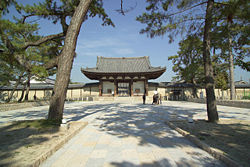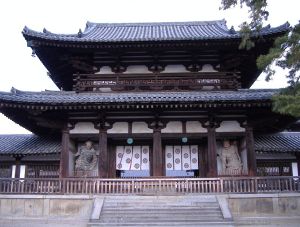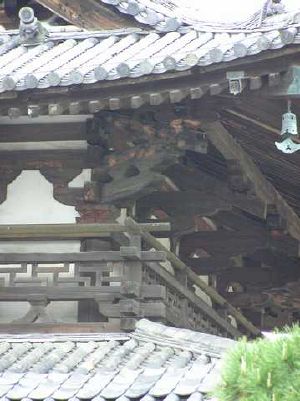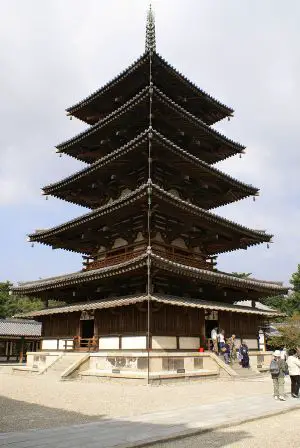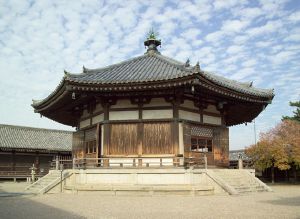Hōryū-ji
| Buddhist Monuments in the Horyu-ji Area* | |
|---|---|
| UNESCO World Heritage Site | |
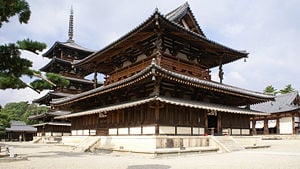
| |
| State Party | |
| Type | Cultural |
| Criteria | i, ii, iv, vi |
| Reference | 660 |
| Region** | Asia-Pacific |
| Inscription history | |
| Inscription | 1993 (17th Session) |
| * Name as inscribed on World Heritage List. ** Region as classified by UNESCO. | |
Hōryū-ji (法隆寺 lit. Temple of the Flourishing Law) is a Buddhist temple in Ikaruga, Nara Prefecture, Japan. Its full name is Hōryū Gakumonji (法隆学問寺), or Learning Temple of the Flourishing Law, named as such because the site serves as a seminary as well as a monastery. The temple is widely acknowledged to have some of the oldest wooden buildings existing in the world, and is one of the most celebrated temples in Japan.[1][2] In 1993, Hōryū-ji was inscribed as a UNESCO World Heritage Site and the Japanese government lists it as a National Treasure.
History
The temple was originally commissioned by Prince Shotoku; at the time it was called "Ikaruga-dera"(斑鳩寺), a name that is still sometimes used. This first temple is believed to have been completed by 607. Hōryū-ji was dedicated to Yakushi Nyorai, the Buddha of healing and in honor of the prince's father.[2] Excavations done in 1939 confirmed that Prince Shotoku's palace, the Ikaruga-no-miya (斑鳩宮), occupied the eastern part of the current temple complex, where the Tō-in (東院) sits today.[3] Also discovered were the ruins of a temple complex which was southwest of the prince's palace and not completely within the present temple complex.[3] The original temple, named by modern historians and archaeologists Wakakusa-Garan (若草伽藍), was lost, probably burned to the ground after being hit by lightning in 670. The temple was reconstructed but slightly reoriented in a northwest position, which is believed to have been completed by around 711.[4] The temple has been repaired and reassembled in the early twelfth century, in 1374, and 1603.[5]
Reconstruction controversy
After the long controversy ignited by architecture historian Sekino in 1905, the majority consensus view as of 2006 is that the current precinct is a reconstruction. The excavations in 1939 that uncovered the older temple site including architectural remains of a Kondo and a pagoda, are accepted as conclusive proof. The original complex, Wakakusa-Garan, probably burned down, but there is still a debate as to whether a fire actually occurred in 670, as recorded on the Chronicles, or whether there was another reason.[6]
Architecture
The present complex
The current temple is made up of two areas, the Sai-in (西院) in the west and the Tō-in (東院) in the east. The western part of the temple contains the Kondo (金堂, Golden Hall) and the temple's five-story pagoda. The Tō-in area holds the octagonal Yumedono Hall (夢殿, Hall of Dreams) and sits 122 meters east of the Sai-in area. The complex also contains monk's quarters, lecture halls, libraries, and dining halls.
Characteristics
The reconstructed buildings embraces the architectural influences ranging from Eastern Han to Northern Wei of China, as well as from the Three Kingdoms of Korea, particularly those of Baekje[3]. With its origin dating back to early 7th century, the reconstruction has allowed Hōryū-ji to absorb and feature a unique fusion of early Asuka period style elements, added with some distinct ones only seen in Hōryū-ji, that were not found again in the architecture of the following Nara period.
There are certain features that suggest the current precinct of Hōryu-ji is not simply representative of the pure Asuka style.[7]
One of the most notable is its layout. While most Japanese temples built during the Asuka period were arranged like their Chinese and Korean prototypes—the main gate, a pagoda, the main hall and the lecture hall on a straight line—the reconstructed Hōryū-ji breaks from those patterns by arranging the Kondō and pagoda side-by-side in the courtyard.[7]
Another example found through the excavations at Yamada-dera, a lost temple originally dated 643, is the difference in the style of the corridor. Whereas Yamada-dera had thicker horizontal poles placed much more densely in the windows, those at Hōryū-ji are thinner, and placed at larger intervals.
On the other hand, major Asuka style characteristics seen in Hōryu-ji, and resembling designs found in the Yungang Grottoes (Northern Wei) are:
- the railings, decorated with repeat-patterned swastika (卍字崩し高欄 manji kuzushi koran), and placed below are the inverted "V" shape support (人字形割束 ninji gata warizuka)
- the entasis columns
The other notable Asuka style element that is only found in Japan to-date, and with the only surviving originals in Hōryu-ji is:
- the cloud-shape hybrid bracket supporter (a 組物 kumimono (hybrid) of 雲斗 kumoto and 雲肘木 kumohijiki)
These Asuka characteristics are not seen in Nara period temples.
Pagoda
The five-story pagoda, located in Sai-in area, stands at 32.45 meters in height (122 feet) and is widely regarded as one of the two oldest wood buildings in the world. The wood used in the center pillar of the pagoda is estimated to have been felled in 594, found through a dendrochronological analysis.[4] The pillar is set three meters below the surface of the massive foundation stone, stretching into the ground. Further below is a hollow for relics, where a reliquary is placed.[8] Although the pagoda is five-storied, it does not function as such to allow one to climb up inside but it is rather designed to inspire people with its external view.[9]
Kondo
The Kondō, located side-by-side to the Pagoda in Sai-in, is widely regarded as the other oldest wood building extant in the world. The hall measures 18.5 meters by 15.2 meters.[7] The hall is two storied, with roofs curved in the corners but only the first story has a double roof (裳階 mokoshi). This was added later in the Nara period with extra posts to hold up the original first roof because it extended more than four meters past the building.[10]
Due to a fire incident that broke out on January 26, 1949, severe damage was caused to the building, mainly its first floor, and the murals. As a result of the restoration (completed in 1954), it is estimated that about fifteen to twenty percent of the original seventh century Kondo materials is left in the current building, while the charred members were carefully removed and rebuilt to a separate fireproof warehouse for future research.[9][5][11]
Through a recent dendrochronological analysis carried out using the materials preserved during the restorations done in the 1950s, it has turned out that some of them were felled prior to 670, suggesting a possibility that the current Kondō was already under construction when "the fire in 670", as recorded in the Chronicles, burned the former Wakakusa-Garan down.[12]
The hall holds the famous Shaka Triad, together with also bronze Yakushi and Amida Nyorai statues, and other national treasures. The wall paintings shown today in the Kondō is a reproduction from 1967.
Yumedono (Hall of Dreams)
Yumedono is one of the main constructions in the Tō-in area, built on the ground which was once Prince Shōtoku's private palace, Ikaruga no miya. The present incarnation of this hall was built in 739 to assuage the Prince's spirit. The hall has acquired its present-day common name in Heian period, after a legend that says a Buddha arrived as Prince Shōtoku and meditated in a hall that existed here. The hall also contains the famous Yumedono Kannon (also Guze,- Kuse-, or Guze Kannon); which is only displayed at certain times of the year.[13]
Treasures
The treasures of the temple are considered to be a time capsule of Buddhist art from the sixth and seventh century. Much of the frescoes, statues, and other pieces of art within the temple, as well as the architecture of the temple's buildings themselves show the strong cultural influence from China, Korea and India and demonstrated the international connection of the countries of East Asia.[14][15]
The Tokyo National Museum holds over 300 objects which were donated to the Imperial Household by Hōryu-ji in 1878. Some of these itmes are on public display, and all are available for study as part of the museum's digital collection....link to Hōryu-ji Treasures at Toyko National Museum
Murals
The murals of Kondō comprise fifty walls; four larger walls, eight mid-sized walls and thirty-eight small wall areas inside the building. The original murals were removed after the fire incident in 1949 and is kept in a non-public treasure house. Twenty small wall paints, escaping from the 1949 fire, are in its original place while reproductions replaced the parts that were removed due to damage.
It is generally believed that the paints on the large walls represents the Pure Land (浄土 jodo) with Shaka, Amida, Miroku and Yakushi Nyorai Bhuddas. Some of the looks and clothing drawn carries certain similarities with murals found in Ajanta Caves (India) or Dunhuang (China.) Also observed are Tang and Inidian flavors of the Bosatsu and Kannon drawn on the sides of the Amida.
Judging from the early Tang influences, the present day consensus on the time of creation of the paintings is end of 7th century. Thus ruling out the possibilities of authorship by those early 7th century figures who were once believed to be the creator, eg. Tori or Doncho (a Goguryeo monk Tamjing, who lived in Ikaruga), there is no one clearly credited to this work.[10][16][17]
Kudara Kannon
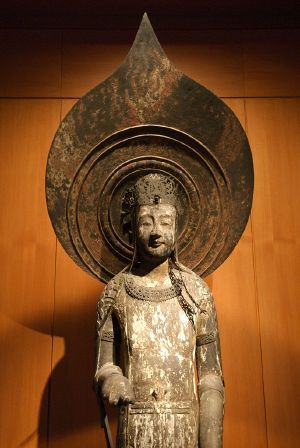
The Kudara Kannon is a statue of Kannon and made of gilded camphor wood. It is 210 centimeters in height[18] and shoulderuing the halo. The statue is unique in Japanese art,[19] and regarded as one of the most important works in the ancient Japan.
The statue is very thin which also creates the illusion of height. The word Kudara is the Japanese for the Baekje Kingdom. The statue was first described in the text written in 1698, although its origin is still unknown. The name was given in the Meiji period, because its style resembled traditional Korean statues, and prior to this the statue was called as Kokuzo Bosatsu. Some art critics believe it to be a Korean creation[20]and another source suggests that the statue was carved in Japan.[18] Japanese art historians indicate that the statue was carved in late 7th century and influenced from the Southern Dynasties styles.
Yakushi Nyorai
The statue of Yakushi of the original temple was saved during the fire of 670.[21] While the temple was being rebuilt the Shaka Triad was commissioned or had been already cast.
Yumedono (Guze) Kannon
This Kannon is a statue that supposedly is the representation of Prince Shotoku. It is approximate six feet and one inch and some sources believe that Shotoku was that height. It is 197 centimeters in height.[18] The kannon is made of gilded wood. It is suggested that the statue was made to assuage the dead prince's spirit based on the fact that the halo was attached to the statue by a nail driven through the head. The statue bears a close resemblance to extant portraiture of the prince. The Kannon retains most of its' gilt. It is in superb condition because it was kept in the Dream Hall and wrapped in five hundred meters of cloth and never viewed in sunlight. The statue was held to be sacred and was never seen until it was unwrapped at the demand of Ernest Fenollosa, who was charged by the Japanese government to catalogue the art of the state and later became a curator at the Boston Museum.[19] Art historians suggest that this figure is based on the Tori style. [18]
Shaka Triad
Tori Busshi is credited with the casting of this massive Buddhist statue. It is a triad and so Sakyamuni, the center Buddha, is attended by two other figures, Bhaisajyaguru to its right and Amitābha to its left. The statues are dated to 623 and the style originates in Northern Wei art.[18] The style of the statue is also known as Tori style and is characterized by the two-dimensionality of the figure and the repetitive pattern-like depictions of the cloth the triad sits upon.[18] At each corner of the triad stand four wooden Shitennō statues from the end of the Asuka period. They are the oldest examples of Shitennō statues in Japan.[22]
Serving the needs of architectural research
The Chronicles of Japan records the arrival of a carpenter and a buddhist sculptor in 577, along with the monks, from Baekje to Japan, which is an underlying fact of importing the mainland expertise through this Korean kingdom with whom Japan enjoyed close relations, in order to build temples locally. These experts are recorded to have stationed in Naniwa, or present-day Osaka, where the Shitennō-ji was built.[23]
There is no record, on the other hand, as to who exactly were the people that have engaged in the constructing of Hōryu-ji, although The Chronicles records the existence of 46 temples in 624.[6] The bracket work of Hōryū-ji resembles that of the partial remainder of a miniature Baekje gilt bronze pagoda.[24] Since there is no surviving architecture of the same period in Korea, Hōryu-ji, being the only wooden structure extant even partially from such time, is a living hint for estimating what Baekje temples would have looked like.[citation needed] In the book of Samguk Sagi concerning the affairs of Baekje, it is recorded that the Yakushi was created by a Baekje craftsmen by Prince Shotoku to assist the recovery of his father, who, as it turned out, passed away before the completion of the temple complex.[citation needed]
ReferencesISBN links support NWE through referral fees
- ↑ Buddhist Monuments in the Horyu-ji Area, UNESCO World Heritage. Retrieved 2007-04-02.
- ↑ 2.0 2.1 June Kinoshita, Nicholas Palevsky (1998). Gateway to Japan, "A Japanese Prince and his temple". Kodansha International. Retrieved 2007-04-02.
- ↑ 3.0 3.1 John Whitney Hall (1988). The Cambridge history of Japan "The Asuka Enlightenment" p.175. Cambridge University. Retrieved 2007-04-03.
- ↑ 4.0 4.1 Web Japan, sponsored by the Ministry of Foreign Affairs, Japan. One hundred years older than supposed?: World Heritage Pagoda. Retrieved 2007-04-04.
- ↑ 5.0 5.1 Marstein, Nils and Knut Einar Larsen (2000). Conservation of Historic Timber Structures: an ecological approach[1]. Elsevier, 22. ISBN 0750634340 Cite error: Invalid
<ref>tag; name "ISBN0750634340" defined multiple times with different content - ↑ 6.0 6.1 Ryōshin Takada 高田良信 (2007). sekai bunka isan Horyuji o kataru 世界文化遺産法隆寺を語る (Horyuji, a World Heritage described). Yanagihara Shuppan 柳原出版, 34-37. Cite error: Invalid
<ref>tag; name "978-4-8409-5016-9" defined multiple times with different content - ↑ 7.0 7.1 7.2 Banister Fletcher, Sir, Dan (EDT) Cruickshank (1996). Banister Fletcher's A History of Architecture, p731. Architectural Press. Retrieved 2007-04-03.
- ↑ Ryōshin Takada 高田良信 (2007). sekai bunka isan Horyuji o kataru 世界文化遺産法隆寺を語る (Horyuji, a World Heritage described). Yanagihara Shuppan 柳原出版, 185-190. The reliquary was shortly salvaged from the hollow, then placed back during the reconstruction of the pagoda in the 1950s, for the purpose of reconditioning.
- ↑ 9.0 9.1 Seiroku Noma (2003). The Arts of Japan, p40. John Rosenfeld (Trans.). Kodansha International. Retrieved 2007-04-03.
- ↑ 10.0 10.1 ISBN0195088913 p20. Not retrievable on the web as of April 2nd, 2007
- ↑ Niels Gutschow, Siegfried RCT Enders (1998). Hozon: architectural and urban conservation in Japan, p48. Edition Axel Menges. Retrieved 2007-04-03.
- ↑ "Find rekindles debate over Horyuji Temple", The Japan Times Ltd., 2004-07-20. Retrieved 2007-04-04.
- ↑ Usually in spring and autumn, for about a month period each. Planned Apr 11-May 18 for 2007.
- ↑ The Archeology of Korea and Cultural Features. Retrieved 2007-04-02.
- ↑ John Whitney Hall (1988). The Cambridge history of Japan "The Asuka Enlightenment" p.176. Cambridge University. Retrieved 2007-04-03.
- ↑ James Huntley Grayson (2002). Korea: A Religious History "Early Korea" p36. Routledge. Retrieved 2007-04-03.
- ↑ Takada, Ryoshin (1998). Horyu-ji no nazo 法隆寺の謎 Mysteries of Horyu-ji. Shogakukan, pp. 131-132. ISBN 4-09-387265-1.
- ↑ 18.0 18.1 18.2 18.3 18.4 18.5 Tsuneko S. Sadao, Stephanie Wada (2003). Discovering the Arts of Japan: A Historical Overview, p42-44. Kodansha International. Retrieved 2007-04-03. Cite error: Invalid
<ref>tag; name "ISBN477002939X" defined multiple times with different content - ↑ 19.0 19.1 Kinoshita, June and Nicholas Palevsky (1998). Gateway to Japan. Kodansha, pp. 587-588. ISBN 477002018X.
- ↑ Chatfield Pier, Garrett (2005). Temple Treasures of Japan[2]. Kessinger Publishing, p.15. ISBN 141796569X. Retrieved 2007-04-03.
- ↑ Robert Treat Paine (1981). The Art and Architecture of Japan , p300. Yale University Press. Retrieved 2007-04-03.
- ↑ (2007) Hōryūji (tourist brochure). Kyoto, Japan: Benrido Co., Ltd., pp. 11-12.
- ↑ Asian Historical Architecture, Horyuji Temple. Retrieved 2007-04-02.
- ↑ Shin Young-hoon. Audio/Slide Program for Use in Korean Studies, ARCHITECTURE, Indiana University. Indiana University. Retrieved 2007-04-03.
See also
- Hokki-ji
- Masaoka Shiki
External links
- Horyuji
- Travel guide to Horyuji from Wikitravel
- Japan Mint: Horyuji Temple Silver Medallion
| |||||||
[[credits|Hōryū-ji|222793312|}}
